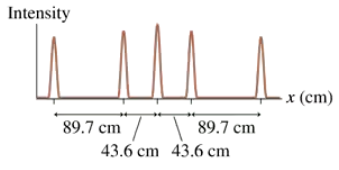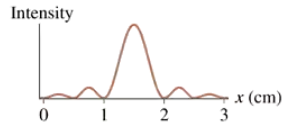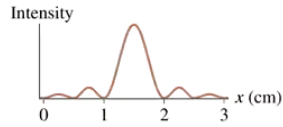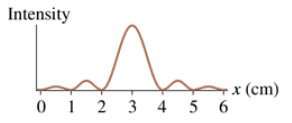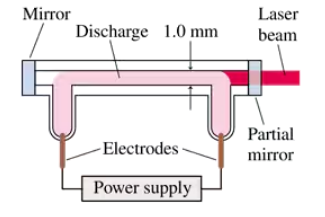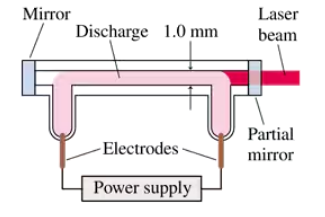 Back
BackProblem 3
Light of wavelength 550 nm illuminates a double slit, and the interference pattern is observed on a screen behind the slit. The third maximum is measured to be 3.0 cm from the central maximum. The slits are then illuminated with light of wavelength 440 nm. How far is the fourth maximum from the central maximum?
Problem 7
In a double-slit experiment, the slit separation is 200 times the wavelength of the light. What is the angular separation (in degrees) between two adjacent bright fringes?
Problem 8
A double-slit interference pattern is created by two narrow slits spaced 0.25 mm apart. The distance between the first and the fifth minimum on a screen 60 cm behind the slits is 5.5 mm. What is the wavelength (in nm) of the light used in this experiment?
Problem 13
A diffraction grating produces a first-order maximum at an angle of 20.0°. What is the angle of the second-order maximum?
Problem 15
The two most prominent wavelengths in the light emitted by a hydrogen discharge lamp are 656 nm (red) and 486 nm (blue). Light from a hydrogen lamp illuminates a diffraction grating with 500 lines/mm, and the light is observed on a screen 1.50 m behind the grating. What is the distance between the first-order red and blue fringes?
Problem 17
FIGURE EX33.17 shows the interference pattern on a screen 1.0 m behind an 800 lines/mm diffraction grating. What is the wavelength (in nm) of the light?
Problem 20
In a single-slit experiment, the slit width is 200 times the wavelength of the light. What is the width (in mm) of the central maximum on a screen 2.0 m behind the slit?
Problem 22
Light of 630 nm wavelength illuminates a single slit of width 0.15 mm. FIGURE EX33.22 shows the intensity pattern seen on a screen behind the slit. What is the distance to the screen?
Problem 24
Light of 600 nm wavelength passes through a single slit and creates a 2.0-cm-wide central maximum on a screen behind the slit. What wavelength of light will create a 3.0-cm-wide central maximum on a screen twice as far away?
Problem 27
Figure EX33.26 shows the light intensity on a screen behind a single slit. The wavelength of the light is 600 nm and the slit width is 0.15 mm. What is the distance from the slit to the screen?
Problem 29
Two 50-μm-wide slits spaced 0.25 mm apart are illuminated by blue laser light with a wavelength of 450 nm. The interference pattern is observed on a screen 2.0 m behind the slits. How many bright fringes are seen in the central maximum that spans the distance between the first missing order on one side and the first missing order on the other side?
Problem 31
Your artist friend is designing an exhibit inspired by circular-aperture diffraction. A pinhole in a red zone is going to be illuminated with a red laser beam of wavelength 670 nm, while a pinhole in a violet zone is going to be illuminated with a violet laser beam of wavelength 410 nm. She wants all the diffraction patterns seen on a distant screen to have the same size. For this to work, what must be the ratio of the red pinhole’s diameter to that of the violet pinhole?
Problem 33
Infrared light of wavelength 2.5 μm illuminates a 0.20-mm-diameter hole. What is the angle of the first dark fringe in radians? In degrees?
Problem 34
Light from a helium-neon laser (λ = 633 nm) passes through a circular aperture and is observed on a screen 4.0 m behind the aperture. The width of the central maximum is 2.5 cm. What is the diameter (in mm) of the hole?
Problem 35
You want to photograph a circular diffraction pattern whose central maximum has a diameter of 1.0 cm. You have a helium-neon laser (λ=633 nm) and a 0.12-mm-diameter pinhole. How far behind the pinhole should you place the screen that's to be photographed?
Problem 37
A Michelson interferometer uses red light with a wavelength of 656.45 nm from a hydrogen discharge lamp. How many bright-dark-bright fringe shifts are observed if mirror M₂ is moved exactly 1 cm?
Problem 39a
FIGURE P33.39 shows the light intensity on a screen 2.5 m behind an aperture. The aperture is illuminated with light of wavelength 620 nm. Is the aperture a single slit or a double slit? Explain.
Problem 40b
FIGURE P33.40 shows the light intensity on a screen 2.5 m behind an aperture. The aperture is illuminated with light of wavelength 620 nm. If the aperture is a single slit, what is its width? If it is a double slit, what is the spacing between the slits?
Problem 43
Two vertical, high-frequency radio antennas are 20 m apart. 2.0 km away, in a plane parallel to the plane of the antennas, 'bright' spots of radio intensity are spaced 5.0 m apart, separated by spots with almost no radio intensity. What is the radio frequency?
Problem 45
Helium atoms emit light at several wavelengths. Light from a helium lamp illuminates a diffraction grating and is observed on a screen 50.00 cm behind the grating. The emission at wavelength 501.5 nm creates a first-order bright fringe 21.90 cm from the central maximum. What is the wavelength of the bright fringe that is 31.60 cm from the central maximum?
Problem 49
White light (400–700 nm) incident on a 600 lines/mm diffraction grating produces rainbows of diffracted light. What is the width of the first-order rainbow on a screen 2.0 m behind the grating?
Problem 51b
Use your expression from part a to find an expression for the separation Δy on the screen of two fringes that differ in wavelength by Δλ.
Problem 57
A diffraction grating has slit spacing d. Fringes are viewed on a screen at distance L. Find an expression for the wavelength of light that produces a first-order fringe on the viewing screen at distance L from the center of the screen.
Problem 62a
A helium-neon laser (λ = 633 nm) is built with a glass tube of inside diameter 1.0 mm, as shown in FIGURE P33.62. One mirror is partially transmitting to allow the laser beam out. An electrical discharge in the tube causes it to glow like a neon light. From an optical perspective, the laser beam is a light wave that diffracts out through a 1.0-mm-diameter circular opening. Can a laser beam be perfectly parallel, with no spreading? Why or why not?
Problem 62c
A helium-neon laser (λ = 633 nm) is built with a glass tube of inside diameter 1.0 mm, as shown in FIGURE P33.62. One mirror is partially transmitting to allow the laser beam out. An electrical discharge in the tube causes it to glow like a neon light. From an optical perspective, the laser beam is a light wave that diffracts out through a 1.0-mm-diameter circular opening. What is the diameter (in mm) of the laser beam after it travels 3.0 m? Note that the wave model is appropriate because the spreading, at this distance, is significantly larger than the size of the opening.
Problem 64b
A radar for tracking aircraft broadcasts a 12 GHz microwave beam from a 2.0-m-diameter circular radar antenna. From a wave perspective, the antenna is a circular aperture through which the microwaves diffract. If the antenna emits 100 kW of power, what is the average microwave intensity at 30 km?
Problem 67b
Light of wavelength 600 nm passes though two slits separated by 0.20 mm and is observed on a screen 1.0 m behind the slits. The location of the central maximum is marked on the screen and labeled y = 0. A very thin piece of glass is then placed in one slit. Because light travels slower in glass than in air, the wave passing through the glass is delayed by 5.0×10−16 s in comparison to the wave going through the other slit. What fraction of the period of the light wave is this delay?
Problem 67c
Light of wavelength 600 nm passes though two slits separated by 0.20 mm and is observed on a screen 1.0 m behind the slits. The location of the central maximum is marked on the screen and labeled y = 0. With the glass in place, what is the phase difference Δϕ0 between the two waves as they leave the slits?
Problem 68
A Michelson interferometer operating at a 600 nm wavelength has a 2.00-cm-long glass cell in one arm. To begin, the air is pumped out of the cell and mirror M₂ is adjusted to produce a bright spot at the center of the interference pattern. Then a valve is opened and air is slowly admitted into the cell. The index of refraction of air at 1.00 atm pressure is 1.00028. How many bright-dark-bright fringe shifts are observed as the cell fills with air?
Problem 71d
In the atom interferometer experiment of Figure 38.13, laser-cooling techniques were used to cool a dilute vapor of sodium atoms to a temperature of 0.0010 K=1.0 mK. The ultracold atoms passed through a series of collimating apertures to form the atomic beam you see entering the figure from the left. The standing light waves were created from a laser beam with a wavelength of 590 nm. Because interference is observed between the two paths, each individual atom is apparently present at both point B and point C. Describe, in your own words, what this experiment tells you about the nature of matter.

